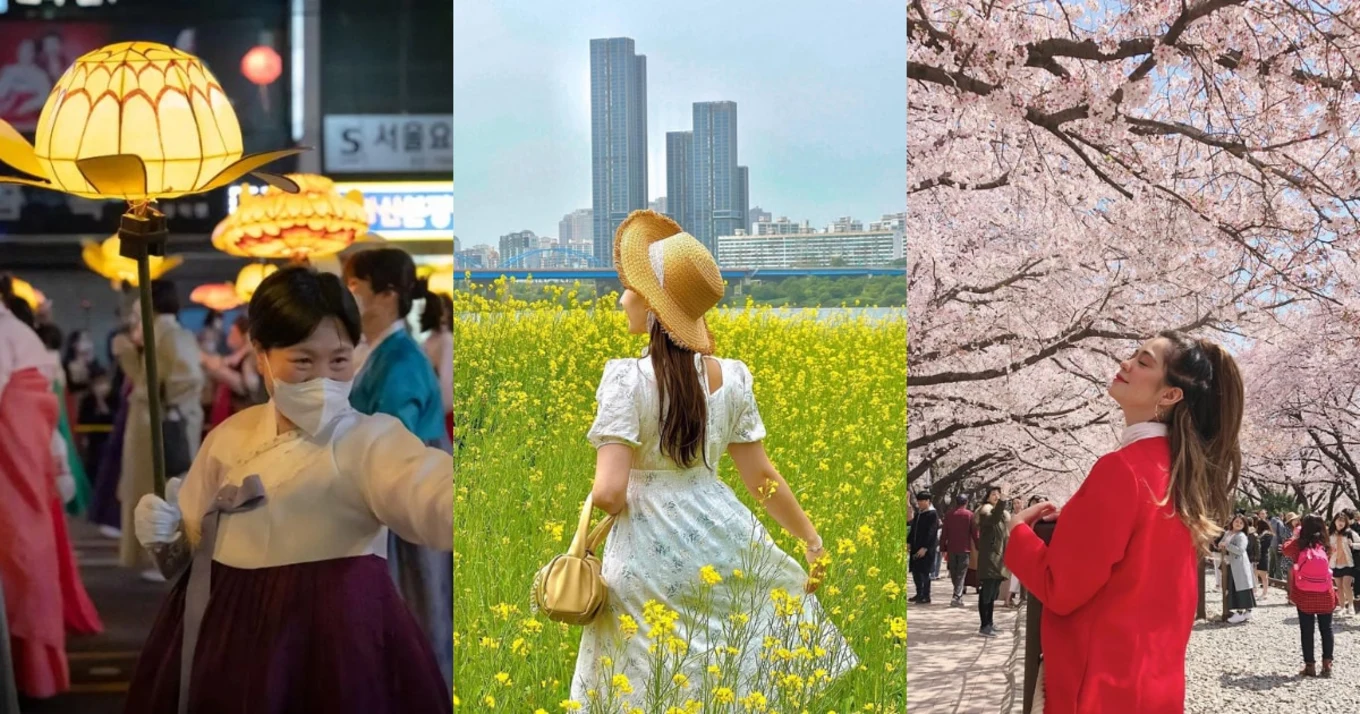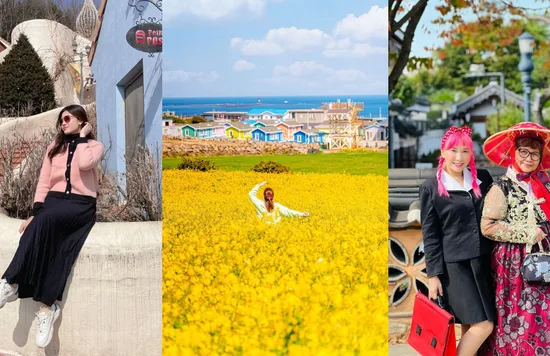Everyone knows that the beginning of spring is the beginning of cherry blossom season, and the spring festivals in South Korea [keyword variation: spring festivals in Korea] celebrate these blooms all over the country. There are flower festivals that pay tribute to the seasonal flora, traditional festivals to wish for good luck in the coming year, and even a fire festival to welcome the season.
South Korea's spring is characterised by cool but comfy weather at around 6 to 18 degrees Celsius—the perfect weather for strolling about or frolicking at a festival. The season usually lasts from March until May or early June, with the southern areas experiencing the changes in weather much sooner. Dress like a local with light sweaters and jackets, long trousers, and lots of layers for the weather.
If you also wanna experience the season like a local, keep reading to see the best Korean festivals you can join as part of our spring guide to South Korea
What are the spring festivals in South Korea?
The flora is truly the main attraction during spring in South Korea, and nearly all the festivals in the country celebrate their blooming periods with cherry blossom-themed food and souvenirs around the viewing spots. There are also other spring festivals that help welcome the new season and the new year.
Whichever you're interested in, here are the South Korean festivals you can look forward to:
1. Jinhae Cherry Blossom Festival, Gyeongsang-do
South Korea in April is packed with spring festivals, but the Jinhae Cherry Blossom Festival is pretty much the largest and the most popular. The Korean festival includes 350,000 cherry trees lining the Yeojwacheon Stream in Jinhae, Gyeongsang-do.
Hundreds of tourists and locals make the trip to see the pink and white petals float through the air for a perfect photo op. Fun fact: Yeojwacheon's bridge is also known as the 'Romance Bridge' since it was the exact filming location of the K-drama "Romance."
Another great spot for seeing the cherry blossoms is at Gyeonghwa Station, where the cherry trees line either side of the rail, and the train passing through the pink trees looks like a scene straight out of a movie.
Several food stalls will be around these areas, but the must-try cherry blossom food here is the accurately named Cherry Blossom bread, which looks exactly like the flower!
How to get there: There's no direct line to Jinhae from Seoul, but you can book day trip tickets through Klook for a hassle-free trip. There are day and night tours for the festival, both of which have their own charms, but if you're more into a bright and romantic vibe, then the morning tour is for you.
If you prefer a night tour more, you'll enjoy a wonderland feel with trees and different installations lit up around the area.
Festival period: March 25, 2024 to April 5, 2024
2. Hangang Seoraeseom Canola Festival, Seoul
Aside from cherry blossoms, spring in South Korea is also the season of canola flowers. Canola plants produce small, yellow flowers with four petals in the shape of a cross. They bloom especially early on Jeju Island, the southernmost tip of South Korea, since it's the first to experience spring thanks to its location.
During this time, the island is covered in a blanket of bright yellow canola flowers. The best spots to see them in full bloom are at the coastline of Seopjikoji, Noksan Road, Jeju Horse Park, and Sanbangsan Mountain.
But if you can't make it to Jeju Island, you can spot the canola flowers at the Hangang Seoraeseom Canola Festival. It's held in Seoraeseom along the Hangang River in Seoul around late April to early May.
Take advantage of the different photo zones to capture that romantic K-drama vibe, or feel free to just hang out and enjoy the live performances or exhibitions; they even have cultural workshops you can join if you wanna try something new!
Klook Tip: Canola flowers have the longest blooming period among the flora of spring festivals in South Korea [keyword variation: spring festival Korea], so there's no need to worry about missing out on them!
How to get there: Take the subway to Gubanpo Station (Line 9), then take Exit 2 towards the Olympic-daero highway. From there, you can follow the street signs to Hangang Park for a 10 to 15-minute walk.
Festival period: There isn't any information about this year's festival yet, but for reference, last year's festival period was from May 12 to May 21, 2023. Check the Hangang Park website for more updates.
3. Taean Tulip Festival, Chungcheong-nam-do
The Taean Tulip Festival isn't just one of the best spring festivals in South Korea [keyword variation: spring festival Korea], it's one of the top five tulip festivals in the world! It takes place in the city of Taean, a city known for stunning beaches, like the pure white sand at Kkotji Beach, delicious fresh seafood, and, of course, one of the most impressive tulip displays.
Get lost in the millions of tulips of different kinds and colours, all of which actually form works of art when you take a second look—so make sure to keep your eyes open. You can also find other gorgeous flowers, like lupine, foxglove, lilies, and more!
It's one of the most-awaited festivals in April, which is why we recommend leaving the bustle of Seoul behind for a short trip down South to Taean.
How to get there: To get to Taean in Chungcheong-nam-do, board an intercity bus from the Dong Seoul Bus Terminal or Express Bus Terminal. From Taean Intercity Bus Terminal, take a village bus to Gomseom and alight at Morenon Bus Stop. If you wanna avoid all the work of buying separate tickets, these Klook tours from Seoul—with a trip to Kkotji Beach, or a trip to a strawberry farm—will make it much easier.
Festival period: April 12, 2024 to May 7, 2024
4. Lotus Lantern Festival, Seoul
The Lotus Lantern Festival, or Yeondeunghoe, is a Korean festival held the weekend before Buddha's birthday according to the lunar calendar, but the festivities last all week long. The tradition began about 1,200 years ago during the Silla dynasty, and it continues today.
It's a different experience from Thailand's two lantern festivals, Yi Peng (the Sky Lantern Festival) and Loy Krathong (the Water Lantern Festival), which take place on the day of the full moon in November.
Look forward to over 100,000 lanterns lit and paraded around the streets of Seoul celebrating Buddha's birthday, symbolising enlightenment, hope, and unity. There'll be lanterns of all shapes and sizes, like lotus flowers, dragons, cranes and more!
Klook Tip: The parade is two hours long, so it's best to catch the beginning of it at Dongdaemun Market or a bit towards the end at Jogyesa Temple. The lanterns will be lit up once they reach the temple, so it'll be easier to snap some pics.
How to get there: Head to Dongdaemun Market by taking the subway Line 1 or Line 4 to Dongdaemun Station, then go through Exit 8 or 9. For Jogyesa Temple, take the subway Line 1 to Jonggak Station, Line 3 to Anguk Station, or Line 5 to Gwanghwamun Station.
Festival period: May 11, 2024
5. Incheon Cherry Blossom and Azalea Festival
Incheon is already a popular destination for all of its historical sites, like Jayu Park (Freedom Park), Chinatown, and Ganghwa-do—the Incheon Cherry Blossom and Azalea Festival just makes the port city that much better.
The festival is held at Incheon Grand Park, which is a must-visit all year round thanks to its natural scenery, but becomes a sea of pink during spring with hundreds of blooming cherry blossoms. Feel free to picnic and cycle around during the Incheon Grand Park Cherry Blossom Festival to make the most of the season's scenery and weather.
While you're roaming around Incheon, you might notice another flower that's in bloom: the multi-coloured azalea. Head to the Wonmisan Azalea Festival near Bucheon Stadium to see a mountain covered in these beautiful flowers.
Stroll through the tall bushes of red, white, pink, and purple azaleas, and you might even find hidden paths or stops where you can take a break amongst the flowers. Note that the azaleas might bloom faster than the cherry blossoms, depending on how warm the weather is, but they do last much longer!
How to get there: You can take a 30-minute cab ride from Incheon Airport to Incheon Grand Park. To get to the Wonmisan Azalea Festival, take the subway Line 7 and get off at Bucheon Stadium Exit 2.
Festival period: Late March to April
6. Seoul Jazz Festival
End the spring season with the Seoul-ful melodies of jazz at this music festival. Spend the night swaying to emotional ballads, smooth tunes, and lively rhythms with your best mates and family.
The 16th Seoul Jazz Festival takes place at four venues in Seoul's Olympic Park, featuring around 60 performances from artists in South Korea and all over the world, including the headliner Lauv, Laufey, Tones and I, Paul Kim, the Yun Seok-cheol Trio, and more!
How to get there: Take the subway Line 5 to Olympic Park Station in Seoul and head to Exit 3.
Festival period: May 31, 2024 to June 2, 2024
7. Year-Round Local Festival Tour
Wanna be able to experience all the best Korean festivals in one go? Book the Year-Round Local Festival Tour on Klook to easily make your way around the best festivals in and around Seoul! It's all the best reasons to visit Korea in the spring in one tour.
Each festival will showcase a part of Korean culture, from the food to the music to the scenery. Fly your own lanterns, marvel at fireworks, make your own kimchi, and more—there are heaps of music, cultural, and flower festivals in Seoul and all over the country.
Experience the highlights of South Korean spring in style! The festivals here are the best way to appreciate and immerse yourself in the culture since you'll be visiting local attractions and trying seasonal delicacies, all while seeing the spring blooms.
These are just seven of the many festivals happening not just in Seoul but throughout the country. There are a tonne more spring festivals in South Korea, including plum blossom and cornelian cherry flower viewings, rose exhibits, green tea harvests, and other activities that you can join in, which you can check out in our spring in South Korea guide.
Plus, the country is beautiful year-round, so make sure to come back for summer, autumn, and winter!
Written by: Gabby Mendoza







![The Wonmisan Azalea Festival will leave you in awe. Credits to @landscapeofkorea on Instgram]](https://res.klook.com/image/upload/fl_lossy.progressive,q_85/c_fill,w_1000/v1709530041/erwzpwtppobikyqf8t1o.webp)
![Come in your best spring outfits to this chill music festival. Credits to @hohosi_ on Instagram]](https://res.klook.com/image/upload/fl_lossy.progressive,q_85/c_fill,w_1000/v1709530171/lnizdzkum03vntntlzdp.webp)
![Is there a better way to enjoy the new season than with your loved ones? Credits to Klook]](https://res.klook.com/image/upload/fl_lossy.progressive,q_85/c_fill,w_1000/v1709530254/tc6zsjxycmuchj1sykfe.webp)





![[Updated] Complete List Of Official Nationwide MCO SOP 2021](https://res.klook.com/image/upload/fl_lossy.progressive,q_85/c_fill,w_160,h_104/v1633858858/blog/iso56uzsphmdguixkvzh.webp)





![[Updated] Complete List Of Official Nationwide MCO SOP 2021](https://res.klook.com/image/upload/fl_lossy.progressive,q_85/c_fill,w_410,h_264/v1633858858/blog/iso56uzsphmdguixkvzh.webp)







